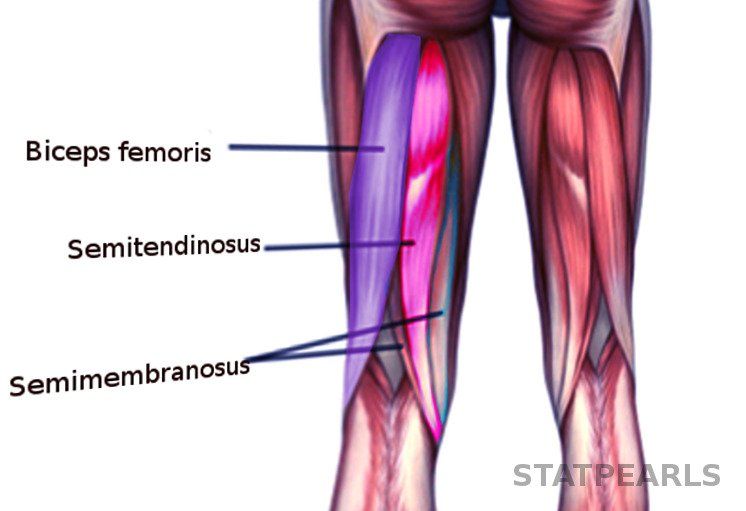
Hamstring injuries are one of the most prevalent injuries across sports, representing between 12-24% of all athletic injuries, especially in European, American football and Sprinting, hence developing these muscles through targeted exercise is generally an important goal of strength and conditioning.
These muscles are a complex of 3 posterior lower-body muscles (biceps femoris, semitendinosus and semimembranosus, Figure 1) that serve as primary extensors of the hip and flexors of the knee. For simplification, lets split these muscle groups into 2 categories: BF (biceps femoris) and SM (semitendinosus + semimembranosus).
BF is crucial, because not only does it displace the most force of the 3 but acts as a shock absorber and driver in high-exertion activities, such as sprints. Exercises which focus on BP are lying leg curls, romanian deadlifts, and glute bridge sliding variations.
SM are more like ‘supporters’ of BF, therefore one could conclude that imbalance in the hamstring would increase the prevalence of injury and a decrease in performance. Exercises which focus on SM are Nordic curls, glute-ham raises and glute bridge slider variations. A famous man (myself) once proclaimed that “your body is like a chain, any weakness in this chain and a fault in the form of an injury will be exposed”.
Must do exercise for athletes, fitness enthusiasts at all levels?
Nordic Curls: with the feet anchored to the floor, hips at 0° flexion and a pushup to include a concentric phase, as shown in the video below. This exercise has consistently been shown to be a career-saver amongst athletes and fitness enthusiasts.
https://www.youtube.com/watch?v=cNBate8f9js
A popular exercise which is not-so-good (according to research)
Stiff-legged deadlifts, especially their unilateral cousins. Whilst these are effective for the glutes (especially when using an eccentric-isometric tempo), they consistently exhibit low muscle activation patterns in studies (Schoenfeld et al. 2015; Tsakalis et al. 2015; Guruhan et al. 2020)
Here are a few other effective hamstring exercises with exception to the lying leg curl..
https://www.youtube.com/watch?v=MJuTRdqnbLw&ab_channel=EliteFitnessPerformance
https://www.youtube.com/watch?v=xgSK7lXeG98&ab_channel=EliteFitnessPerformance
References:
- Guruhan, S., Kafa, N., Ecemis, Z.B. and Guzel, N.A., 2021. Muscle activation differences during eccentric hamstring exercises. Sports Health, 13(2), pp.181-186.
- Prince, C., Morin, J.B., Mendiguchia, J., Lahti, J., Guex, K., Edouard, P. and Samozino, P., 2021. Sprint specificity of isolated hamstring-strengthening exercises in terms of muscle activity and force production. Frontiers in sports and active living, 2, p.211.
- Tsaklis, P., Malliaropoulos, N., Mendiguchia, J., Korakakis, V., Tsapralis, K., Pyne, D. and Malliaras, P., 2015. Muscle and intensity based hamstring exercise classification in elite female track and field athletes: implications for exercise selection during rehabilitation. Open access journal of sports medicine, 6, p.209.
- Schoenfeld, B.J., Contreras, B., Tiryaki-Sonmez, G., Wilson, J.M., Kolber, M.J. and Peterson, M.D., 2015. Regional differences in muscle activation during hamstrings exercise. The Journal of strength & conditioning research, 29(1), pp.159-164.
- McAllister, M.J., Hammond, K.G., Schilling, B.K., Ferreria, L.C., Reed, J.P. and Weiss, L.W., 2014. Muscle activation during various hamstring exercises. The Journal of Strength & Conditioning Research, 28(6), pp.1573-1580.
- van den Tillaar, R., Solheim, J.A.B. and Bencke, J., 2017. Comparison of hamstring muscle activation during high-speed running and various hamstring strengthening exercises. International journal of sports physical therapy, 12(5), p.718.


Start Today!
Ready to transform your fitness journey? Take the first step towards achieving your goals with personal training!
My take on Health and Fitness



